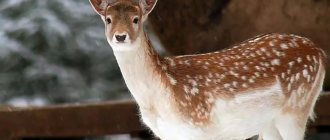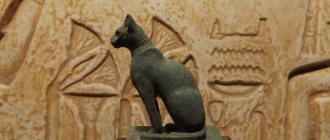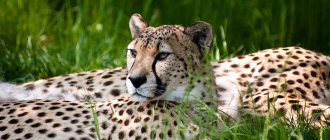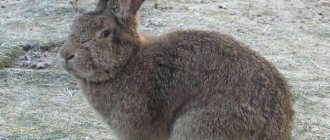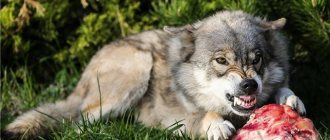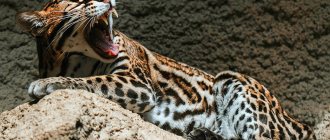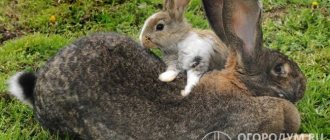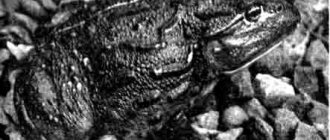The rarest cat breeds in the world are listed in the Red Book. This list includes the little-studied Caucasian forest cat, which lives in the countries of Central Asia, Eastern and Western Europe. She leads a secretive lifestyle and prefers hard-to-reach habitats.
What interesting things have experts learned about this rare breed, and what qualities attract the Caucasian forest cat? Is it possible to keep such a predator at home? You will find answers to these and other questions in our article today!
History of the species
The Caucasian forest cat is a small predator of the cat family, one of those wild animals that have retained their appearance unchanged over millions of years.
In total, there are 23 subspecies of forest cats, and the animal living in the Caucasus Mountains is one of its largest representatives.
The morphology of the animal was formed almost during the Ice Age. Most representatives of the fauna of the Pleistocene period of the Quaternary geological epoch did not survive to this day and became extinct due to global warming. These are, for example, mammoths, woolly rhinoceroses, cave lions.
Caucasian forest cats migrated to the cool zones of foothill forests and managed to retain abundant hair, sharp claws and impressive size for a cat.
Interesting Facts
In the Middle Ages in Spain, the fur of the Pyrenean wild cat was used to make trim for cloaks and dresses of high society. They also made parchment on which, for example, the laws of the Iberian Peninsula were written.
In our time, wild cats still live on the Iberian (Pyrenees) Peninsula. The size of these animals has not changed since the Ancient Quaternary era. The common European wild cat lives in the north of the peninsula, and the giant Iberian cat lives to the south. The last species is one of the largest.
Mr. Cat recommends: characteristics, range of the Caucasian forest cat
The Caucasian forest cat is practically no different from its Central European counterpart.
The main characteristics of the animal's appearance are as follows:
- Quite large sizes. The weight of individuals is from 5 to 13 kg, while females are significantly smaller than males.
- Males reach 65-90 cm in length, cats 55-63 cm.
- The body is strong, massive, muscular. Females have a more graceful structure due to their less voluminous neck.
- The head is medium in size, but appears massive and round due to wide cheekbones.
- The eyes are quite large, yellow, green or swamp-golden in color.
- The ears are large, but not too large, set quite high, and have no tufts, only an inner edge.
- The legs are of medium length, but the hind legs are much longer than the front ones.
- The claws are sharp and strong; they are often ground down on rocks.
- The tail is long, matching the length of the body. It is powerfully pubescent, seems very thick, its tip is rounded.
- Medium length coat with voluminous undercoat.
- The cover is much thicker and longer in winter. In summer, the coat appears shorter and lighter.
- The color is in grayish tones with dark stripes and markings on the forehead, sides, and upper paws. There are several dark rings on the tail. Sometimes there are ocher and brownish colors.
- The vibrissae are large, voluminous and long, white.
- Coarse tufts of hair also grow between the toes on the pads of the feet.
Felis silvestris caucasica live mainly in deciduous mixed forests of the foothills of the Caucasus; they are found in Dagestan, Chechnya, Kabardino-Balkaria, North Ossetia, Georgia, Armenia, Azerbaijan, Adygea and Turkey. Their Central European and steppe counterparts often live next to these animals.
In the Krasnodar and Stavropol regions, this animal also inhabits foothill coniferous forests. In total, its habitat area in the Caucasus and Asia Minor is small, up to one and a half thousand hectares.
This is one of the smallest subspecies of the wild forest cat. So, in Dagestan there are only about a hundred individuals.
They are able to live at an altitude of 2-3 thousand meters above sea level.
In treeless areas, they inhabit floodplains - often flooded areas in river floodplains or near lakes, covered with reeds, thistles and shrubs. Although the beast does not like water.
Description of Pallas's cat
The description of the Pallas's cat can begin with its appearance. The Pallas cat looks similar to a regular cat, only larger and fluffier. The dimensions of the Pallas's cat range from 50 to 65 cm with a tail length of up to 30 cm. The Pallas's cat weighs from 2 to 5 kg. The wild manul cat differs from an ordinary cat in its more massive body, short strong legs and very thick six. By the way, six Pallas' cats can reach a length of 7 cm. The Pallas cat has the fluffiest and thickest fur among cats.
In the description of the manul, it should be noted that this cat has a rather angry appearance, which makes it very memorable. The Pallas's cat looks stern due to the peculiar “whiskers” on its cheeks, which are formed by tufts of long hair. The Pallas' cat animal has a wide, flattened head and small, widely spaced, rounded ears. Pallas' cat's eyes are very expressive and yellow in color.
Surprisingly, the pupils of these cats’ eyes, unlike the pupils of a domestic cat, do not narrow in bright light, but remain round. The wild Pallas cat has a long fluffy tail with a rounded tip. The color of the Pallas's cat is combined and is represented by the colors of light gray and yellowish-brown.
Manul looks unusual. Since the ends of the hairs of its fur are painted white, it seems as if the Pallas' cat's fur is dusted with snow or covered with frost. The back of the body and tail have narrow transverse stripes of a dark color. Black stripes stretch from the corners of the eyes and along the sides of the muzzle, and there are specks of dark color on the forehead. The lower part of the animal's body is brown with a white coating. The tip of the tail is colored black. The manul cat has sharp teeth and claws.
The Pallas cat animal has a very specific appearance. It is believed that this cat is related to Persian cats. The wild manul cat was discovered by the German scientist Peter Pallas, who in the 18th century conducted research on the coast of the Caspian Sea. It was in his honor that the manul received the name “Pallas cat”.
Features of behavior
In forest foothills, the Caucasian forest cat usually makes a den in a tree in a hollow; it can also take a liking to the abandoned nest of a heron, an eagle or a stork.
In rocky areas, shelters become crevices in rocks, holes left by badgers, foxes, and sometimes even wolves.
In the floodplains, it can choose an entire island as its zone, arranging a den and a playground for the young in its center. The toilet area is usually located near the water itself.
Caucasian forest cats are very cautious animals that lead a rather secretive lifestyle, preferring a solitary existence.
One adult male usually chooses “his” territory of two to three square meters. km. Its boundaries are carefully marked with urine, and characteristic scratches are left on tree trunks.
They move to new lands extremely rarely and reluctantly, only due to human intervention or when the food supply is scarce.
It goes hunting in the twilight hours, before sunset or dawn. Never pursues prey, always uses wait-and-see tactics. It kills the victim in a swift jump, biting the back of the head or neck.
All forest predators that are comparable to or larger than the Caucasian cat are his enemies - bears, lynxes, wolves, foxes, martens, weasels, jackals. It is not easy to catch up with the animal; it immediately hides in a tree or in emergency shelters on “its” territory.
Nutrition
The food preferences of the Hausa are manifested among waterfowl and fish; it is no coincidence that it swims and dives well. It also easily catches small rodents, gophers, hares, and even small piglets.
It guards prey near a nest or trail, jumping high and deftly after it. Muddy or swampy areas do not frighten the hunter; dense wool protects from getting wet. The ability to wait and attack quickly always provides the animal with prey. In general, the house is not picky about food. He is full if he gets two mice or one rat in a day.
Domestic tamed cats should be fed lean meat, and do not forget about herbal and vitamin supplements.
Diet
The Caucasian forest cat is a medium-sized predator that is excellent at climbing trees and rocks. To hunt, the animal prefers to go down to the ground.
Most of its diet consists of rodents - mice, voles, dormice. I am ready to fight with such brave enemies as weasel, ermine, raccoon, rat, muskrat, nutria. Capable of catching a hare, snake, baby roe deer or deer.
Most of all he likes to hunt birds whose nests are located on the ground - pheasants, partridges, chukars, ducks.
Does not like to swim, but sometimes goes down to the water to catch fish, frogs or toads.
During the hungry season, it does not refuse lizards, insects, berries and herbs; it can enter human settlements and carry chickens, geese and turkeys, although it avoids people with all its might.
It does not move well in the snow, so it does not choose such areas for living and hunting.
The Caucasian cat eats a lot - an adult can eat up to twenty mice a day, and a teenager can eat about ten.
Interesting facts about the animal
- On the territory of modern Russia, the cat was domesticated approximately 2,700 years ago.
- The wild cat lives at an altitude of 2500-3000 m above sea level. The mountainous region is the most convenient place for an animal to live.
- The animal prefers to sit in ambush and attack the victim suddenly. But he catches a hare without any problems.
- Wild cats spread thanks to the Roman conquerors. They began to interbreed with wild cats. When Roman troops conquered Britain, these animals began to be used not only to protect outbuildings from mice, but also as fighting animals. There were times when the value of a cat exceeded the value of a bull.
- Nowadays you can buy a real forest cat. They are bred in special nurseries. The price of such an individual ranges from 10 to 50 thousand rubles. The cost depends on the purebred and external characteristics.
Still have questions about the wild cat or have something to add? Then write to us about it in the comments, this will make the material more useful, complete and accurate.
Puberty and reproduction
During the year, this predator reproduces once or twice. A pair is created only during the rutting period and mating in February-March. Males often engage in fights for the female.
When pregnancy occurs, the cat prepares a den, lining it with moss, grass and bird feathers. After about two months, the offspring are born, containing from two to six cubs. Kittens are born with their eyes closed and are absolutely helpless. Their color is darker than that of adult animals, the spots are brighter and more distinct.
The babies feed on mother's milk until they are three to four months old, but the female begins to bring them prey from about one and a half months. At 60 days they are already learning hunting skills, actively playing in front of the hole and climbing trees. By six months, adolescents typically leave their mother.
Puberty in females occurs at 9-10 months, in males - at 2-3 years.
Life expectancy in captivity is 25-30 years, in the wild it is much less - 12-15.
Felis chaus chaus (Schreber, 1777)
Range: Russia (along the northwestern coast of the Caspian Sea within the Astrakhan region, the republics of Kalmykia and Dagestan, as well as in Chechnya, Ingushetia and North Ossetia), Azerbaijan, Armenia, Georgia, Kopetdag (Turkmenistan), Iran and parts of Turkey bordering the Transcaucasus , Iraq, Syria and adjacent parts of Turkey.
The distribution of the reed cat due to its attachment to river valleys and other lands rich in water, some with forests, is very uneven - the outlines of the range are very complex; it also has vast spaces where animals are absent.
In the north-west, the jungle cat was found in the Volga delta (last recorded in 1986). From the Volga delta the range stretches as a narrow ribbon corresponding to the width of the reed thickets. Where there are no reed thickets, it lives in the bush thickets of the coastal strip or foothills.
Keeping the Caucasian forest cat in captivity
The Caucasian forest cat is undesirable in the house as a pet.
A kitten that is immediately weaned from its mother and hand-fed may show some signs of socialization before puberty. As it grows, a wild disposition will certainly develop, and the animal can become dangerous to humans.
It is better to allocate a separate large enclosure for an exotic pet so that the cat can actively move. You should not allow the animal to come into contact with other pets.
You should choose a complete meat diet, consisting mainly of poultry, rodents and vitamin and mineral supplements.
These cats, like domestic ones, need timely treatment for external and internal parasites and timely vaccinations.
The health of the Caucasian cat is excellent, but only if high-quality conditions of keeping and nutrition are provided.
ATTENTION, TEST! Answer a few simple questions and find out what kind of owner you are for your cat:
Does your cat have a name?
How often do you play with your pet?
Do you get your vaccinations and parasite treatment up to date?
Is your kitten spayed/neutered?
What do you feed your purr?
Share your Results:
Facebook Twitter Google+ VK
Wild cats of the Krasnodar Territory and the Crimean region make up the largest population of these cats. Particularly high density is observed in the foothills.
Purchasing a kitten
A kitten should only be purchased from a professional breeder. The cost starts from 35-40 thousand rubles. In foreign nurseries, prices are much higher.
You should think a hundred times whether such an unsociable, restrained in showing emotions, but at times aggressive pet is needed in the house.
In addition, as an endangered species, the Caucasian forest cat is listed in the Red Book of the Russian Federation. Its illegal acquisition and maintenance is punishable by law.
1111
Number
Human activity is the main factor in the disappearance of many animal species from the face of the Earth. Previously, relative records of animals were kept by the number of skins obtained. The minimum population was 1800 animals, the maximum was 3500.
The Caucasian forest cat also lives in the Caucasian State Natural Biosphere Reserve; there are about 120 individuals of both sexes. The population is relatively stable and decreases only in severe winters.
The main reasons for the decline in numbers are considered to be:
- reduction of habitat due to chaotic deforestation;
- illegal hunting;
- unfavorable environmental conditions (especially in winter).
Enthusiasts are trying to increase the population of animals such as the Caucasian forest cat. The Red Book helps save these mysterious animals. The preservation of unique broad-leaved forests in the North Caucasus guarantees the life of forest predators.
